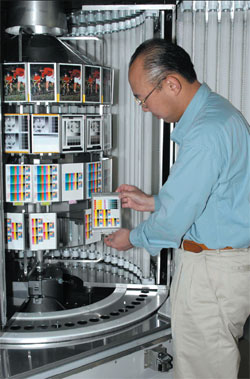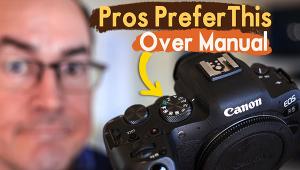Print Permanence; An Epson White Paper Page 3
Inconsistent testing practices generate considerable confusion for consumers
who cannot then accurately compare the ratings for different brands of paper
and ink with the ratings provided by the manufacturers of their printers. In
addition, the lower test criteria lead to an escalation of print permanence
claims to the point of absurdity. For example, under the forgiving test criteria
used by Eastman Kodak, some Epson prints could be predicted to last longer than
an incredible 1,000 years. Epson is opposed to giving credibility to such unrealistic
claims. We believe users should be aware of test criteria that dramatically
inflate print permanence ratings. We believe they should not trust their memories
and/or reputations to products that are tested with overly lenient procedures
rather than according to more accepted test practices.
· Dark Keeping
While storage in the dark will generally increase the effective life of a photographic
print, one should not assume that dark keeping will always produce greater longevity.
It is important to know the effects of light on imaging materials or combinations
of materials from different manufacturers. It is equally important to know how
the very same materials will behave in dark storage. Some products may have
dark keeping properties that are in hundreds of years but are rated only at
10-20 years when exposed to light; Therefore consumers should be particularly
careful of any manufacturer making longevity claims based on dark keeping or
album storage alone. Conversely it is possible, with the numerous permutations
available from using ink and paper combinations made by companies other than
the manufacturer of a printer, to produce a print that has good light stability
but poor dark keeping.

Lightfastness Testing Chamber, Seiko Epson Corporation

Lightfastness Testing Chamber, Seiko Epson Corporation
· Temperature and Humidity
High temperatures and high humidity levels adversely affect all color print
materials and cause the colors in traditional silverhalide photographic images to deteriorate more rapidly. The behavior of inkjet materials
can vary widely, again depending upon the different types of papers used and if the inks are dye or pigment-based.
In humid conditions, inkjet prints made with dyes, particularly those that have been printed on swellable papers, tend to
lose sharpness and suffer from changes in color balance and density due to dye migration. Inkjet prints made with pigment-based
inks are usually much less sensitive to high temperature and high humidity than traditional silver-halide prints and dye-based
inkjet prints. Prolonged storage in high humidity can produce fungal growth on all prints, including silver-halide.
· Gaseous Pollutants
Gaseous pollutants can adversely affect inkjet prints. Printer manufacturers
have made important advancements in ozone resistance for both pigment and dye-based inks. But dye-based inks printed on
porous papers can still be vulnerable to the effects of high levels of ozone in homes and offices or when they are close
to ozone producing devices such as copier machines, computer monitors and air filtration systems. For shorter term display, most
dye-based inks are sufficiently resistant to ozone. For longer term display, framing prints behind glass or storing them in albums
can prevent ozone damage. Inkjet prints made with pigment-based inks are less susceptible to ozone damage and will have greater
permanence characteristics than prints made with dye-based inks in the same conditions. Traditional silver-halide color
prints are not specifically affected by ozone, but may be vulnerable to other atmospheric contaminants such as smoke. Traditional
silver-halide prints will, for the most part, fade due to light before an inkjet print made with pigment-based ink is affected
by ozone.

Environmental Testing Chambers, Seiko Epson Corporation

Environmental Testing Chambers, Seiko Epson Corporation
· Water
The chance of water damage increases as prints are displayed or stored for extended
periods of time. Likely sources are spills;
overspray from cleaning; sneezing; wet or sweaty hands; floods; or leaky pipes
and roofs. Dye-based inkjet prints, especially
those printed on swellable papers, are susceptible to water damage any time
a print is touched with wet hands or otherwise
comes in contact with water. Pigment-based inkjet prints are relatively water
resistant unless inappropriately used in conjunction with a swellable polymer
paper, such as Kodak Ultima.
· What We All Need to Do
To make an informed decision on papers and inks, consumers and professional
photographers alike must take into account all
permanence-related factors as well as the image quality characteristics of any
product. There simply is no magic paper that will work with all types of inkjet
systems without some kind of significant compromise.
Comparative and rigorous print permanence tests are important for both the amateur
and the professional for all types of
photographic prints whether they are silver-halide, dye-sub or inkjet. To preserve
precious memories, the amateur
photographer must make correct choices of materials based on unbiased print
permanence research. And professional
photographers need to recognize that their products will often be displayed
by the buyer in lighting conditions containing ultraviolet radiation with lux
levels that are significantly higher than 120. If these prints fade prematurely,
the professional's reputation and livelihood is at risk.
· Compatibility Claims Can Lead to Unfortunate Compromises
An inkjet print is the product of a closely interrelated system of printer,
ink and paper working together. Epson does extensive
research during all stages of product development to optimize this system to
ensure high levels of both image quality and print
permanence. Products from third parties labeled as "compatible with"
or "suitable for" are often one-size-fits-all claims that rely
only on the lowest common denominator. While there may be certain combinations
of third party ink and paper that yield
acceptable results on certain printers, there are numerous
examples of prints made with combinations of ink and media that
will produce poor image quality and/or lead to print fading in only
a few years.
Unfortunately guarantees of longevity typically only involve the
replacement of paper. So if a print with a 100-year claim fades in
real life conditions in less than 20 years, the owner of the faded
print may only receive replacement paper as compensation. But
at that time, it may be difficult or impossible to locate a usable
digital file to reprint the image, and just like what happened in the
1980s with prints made in the 1960s, an important memory could
be lost forever.
Should Every Print Last Forever?
A recent study showed that 72% of consumers think a
photograph should last forever. But photography is not only
about memories or fine art exhibition. There are applications and
situations where surface texture, speed, productivity, size, etc.
may be more important. Therefore Epson makes a variety of
printers, inks, and papers and has the know-how to combine
them to deliver suitable combinations of longevity and quality for
different applications.
Often one does not know the importance of an image until many
years have gone by. And often our most treasured images are
displayed for long times in a wide variety of environmental
conditions that may prove to be detrimental to prints. When
Epson pigment inks are used as directed with a wide variety of
Epson media, these prints will have better print permanence than
any Eastman Kodak silver-halide or dye-sub color print.
Conservators have recommended that even for short-term
display, or when the desire to save a print is uncertain, it is
always best to frame all types of images behind glass. Framing
behind glass provides protection against accidental spills,
fingerprints and exposure to a wide variety of airborne pollutants
such as cigarette smoke and cooking vapors.
Industry Accepted Practices & Comparative Tests
Most manufacturers of traditional and digital photographic
materials follow industry accepted test practices. While any
predictive test cannot be seen as a guarantee, comparative
testing by an independent third party laboratory such as Wilhelm
Imaging Research, Inc. using accepted industry practices allows
consumers and professionals to make informed decisions based
on how different products perform relative to each other under
the same conditions.
Most people probably would not find it acceptable for each
automobile company to test fuel efficiencies of their cars by their
own criteria rather than by government mandated miles-pergallon
standards. Likewise, consumers and professionals alike
should be wary of any company making claims of image quality
and/or print permanence based on test methodologies that fall far
short of the criteria used by the rest of the industry. Consumers
and professionals also should be cautious about data published
or referenced from a third party using a manufacturer's
proprietary practices. Third parties can be commissioned by a
manufacturer to verify results with the manufacturer's own set of
non-industry accepted practices. When this happens the third
party is not making any endorsement of or recommendation for
the product that was tested, but is merely providing verification of
data gathered under that manufacturer's particular set of
conditions. Consumers must have apple-to-apple comparative
data to make informed choices.
Why You Should Care
If consumers and professional photographers do not insist on
unbiased comparative data obtained with rigorous test
procedures and confirmed by reputable independent test
laboratories, we see three profound negative outcomes:
· The public will not be able to get accurate and meaningful
information to make informed purchase decisions about which
products can be counted on to produce photos they will
cherish and pass on to their children.
· Companies may have to shift research and development
funding for continual print permanence improvements over to
marketing efforts in order to compete against those who
choose to lower the playing field.
· The credibility and reputation of photography itself
will be at risk as:
· A reliable method to preserve memories
· A credible way to document the times in which we live
· A viable and valuable fine art in itself
Conclusion
We at Epson believe consumers should have access to
unbiased comparative print permanence data based on
uniform rigorous test criteria so they can make informed
choices about the photographic materials on which they print
their precious memories. The long-term survival of
photographs and our photographic heritage must not be
shortchanged by overstating the permanence characteristics
of any paper, ink, other imaging material, or their
combinations.
Photographs are simply too important to our civilization
to be subjected to undisclosed compromises about their
longevity.
Epson and PictureMate are registered trademarks and Epson UltraChrome K3 is a
trademark of Seiko Epson Corporation. DuraBrite is a registered trademark of
Epson America Inc. Third party and product names are trademarks or registered
trademarks of their respective holders.
- Log in or register to post comments

































